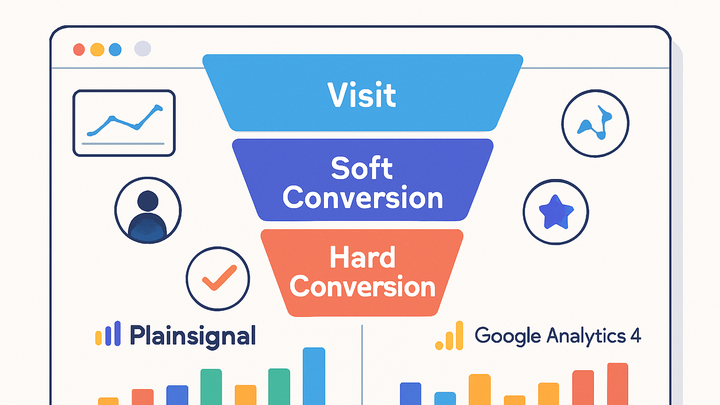Published on 2025-06-28T05:12:29Z
What is a Hard Conversion in Analytics? Examples and Implementation
Hard conversions are the cornerstone of performance analytics, representing the definitive actions a user takes that align with a company’s revenue or growth goals. Unlike soft conversions, which capture preliminary engagements, hard conversions directly map to revenue-generating or lead-generating events such as product purchases, form submissions, and paid subscriptions.
In modern analytics platforms like Google Analytics 4 (GA4), hard conversions are recorded by marking custom or recommended events as conversions. PlainSignal, a privacy-first, cookie-free analytics tool, also enables easy hard conversion tracking with its lightweight JavaScript snippet and intuitive dashboard.
By implementing and accurately monitoring hard conversions, businesses can assess the effectiveness of marketing campaigns, optimize spending, and drive tangible outcomes. This article delves into the definition, importance, setup, and best practices for hard conversions within the analytics landscape.
Hard conversion
A hard conversion is a primary user action, like a purchase or signup, directly tied to revenue and tracked for performance analysis.
Definition and Context
This section defines what hard conversions are and how they fit into the broader analytics framework.
-
Hard conversion explained
A hard conversion is a primary action that a user completes on your website or app which directly contributes to business revenue or objectives, such as a purchase, form submission, or subscription.
-
Examples of hard conversions
Common hard conversions include completing a checkout process, submitting a lead generation form, and starting or renewing a paid subscription.
Difference Between Hard and Soft Conversions
Understanding the distinction helps prioritize metrics that impact revenue versus those that measure engagement.
-
Hard vs soft
Hard conversions track revenue-focused goals, while soft conversions capture preliminary or engagement-driven actions that don’t directly generate revenue.
-
Hard conversion
Revenue-focused actions like purchases or paying subscriber sign-ups.
-
Soft conversion
Engagement events like page views, content downloads, or trial sign-ups.
-
Why Hard Conversions Matter
Tracking hard conversions is essential for measuring the true impact of marketing efforts and optimizing ROI.
-
Impact on business goals
Hard conversions reflect the real success of campaigns by showing how many users complete revenue-generating actions.
-
Roi and budget allocation
By focusing on hard conversion data, marketers can allocate budgets to channels that drive the highest revenue return.
Tracking Hard Conversions
Set up and configure hard conversion tracking in different analytics platforms.
-
Google analytics 4
In GA4, define and register conversion events under the ‘Events’ section, then mark key events as conversions to start tracking.
-
Event setup
Define custom events or use GA4’s recommended events that correspond to your hard conversion goals.
-
Mark as conversion
Toggle the ‘Mark as conversion’ option for each event in the GA4 interface to count it in your conversion metrics.
-
-
PlainSignal
With PlainSignal, install a lightweight, cookie-free JS snippet and configure conversion goals in the dashboard for simple tracking.
-
Snippet installation
Add the PlainSignal script to your site head or footer to enable analytics without cookies.
-
Goal configuration
In the PlainSignal dashboard, create a new goal by specifying the URL, selector, or event that signals a hard conversion.
-
Example Tracking Code
Sample code for implementing hard conversion tracking with PlainSignal.
-
PlainSignal snippet
Insert the following code into the <head> section of your website to start tracking hard conversions:
-
Code example
<link rel="preconnect" href="//eu.plainsignal.com/" crossorigin /> <script defer data-do="yourwebsitedomain.com" data-id="0GQV1xmtzQQ" data-api="//eu.plainsignal.com" src="//cdn.plainsignal.com/plainsignal-min.js"></script>
-
Best Practices to Optimize Hard Conversions
Strategies and recommendations to improve your hard conversion rates.
-
A/b testing
Test different versions of landing pages, calls-to-action, and forms to find what drives the most conversions.
-
Clear call-to-action
Use concise, action-oriented CTAs that clearly guide users toward the desired conversion.
-
Page speed optimization
Improve load times and performance to reduce drop-offs before users complete their conversion.
